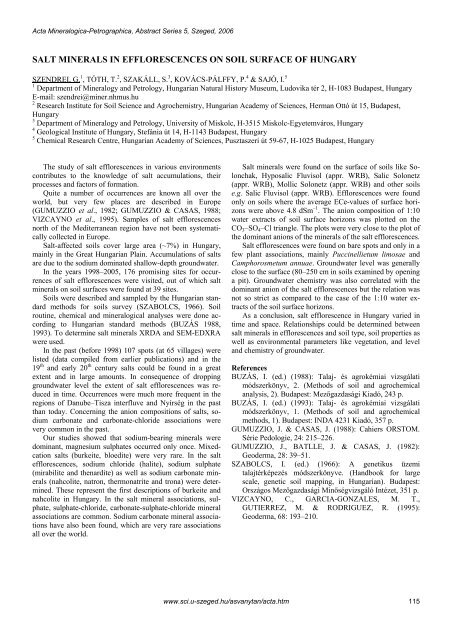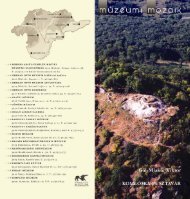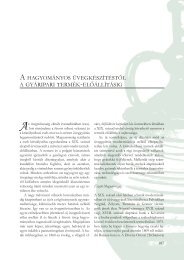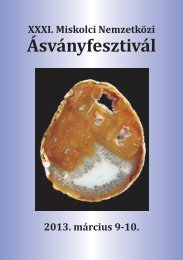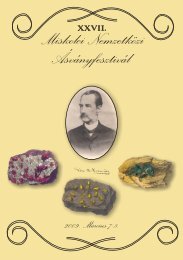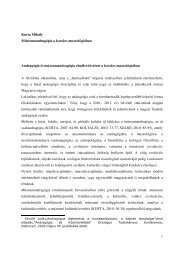Acta Mineralogica-Petrographica, Abstract Series 5, Szeged, 2006POSTMAGMATIC ALACRANITE (?) FROM <strong>THE</strong> CIOMADU AREA, SOUTH HARGHITA,ROMANIASZAKÁLL, S. 1 , PAPUCS, A. 2 , JÁNOSI, CS. 3 , KRISTÁLY, F. 1 & PÁL-MOLNÁR, E. 21Department of Mineralogy and Petrology, University of Miskolc, H-3515 Miskolc-Egyetemváros, HungaryE-mail: askszs@gold.uni-miskolc.hu2Department of Mineralogy, Geochemistry and Petrology, University of Szeged, P.O. Box 651, H-6701 Szeged, Hungary3 Csík County Nature and Conservation Society, Szív str. 3/14, RO-530225 Miercurea Ciuc, RomaniaAlacranite, As 8 S 9 , monoclinic with space group P2/c, wasfirst described by POPOVA et al. (1986) from the Uzoncaldera (Kamchatka, Russian Federation). The mineral occurswith realgar and uzonite as flattened and prismatic grains upto 0.5 mm across, serving as cement in sandy gravel. Alacraniteand other arsenic minerals are recent products of solfatarasand hot springs in the central part of the Uzon caldera.The structure of alacranite consists of an ordered sequenceof As 4 S 4 and As 4 S 5 cage-like molecules, with a molecularpacking closely resembling that found in the β-As 4 S 4phase (BONAZZI et al., 2003a). The unnamed natural β-As 4 S 4 phase was first described by CLARK (1970) fromAlacrán mine, Chile, as a high-temperature phase (stable inthe As-S system at temperatures above 256 °C), whereasrealgar is the low-temperature (α-) form of As 4 S 4 . Alacranitewas named by POPOVA et al. (1986) for the similarities ofthe XRD pattern of the samples from the Uzon caldera tothose from Alacrán mine. New chemical and crystallographicdata (BONAZZI et al., 2003b) suggest the existence of acontinuous series between natural β-As 4 S 4 and alacranite. Itis now evident that minerals with chemical composition rangingcontinuously from As 8 S 8 to As 8 S 9 can crystallize.Arsenic mineralizations in the surroundings of CiomaduareaThe first reference to arsenic mineralization in the areawas published by HAUER (1860). He described realgar,sulfur and aragonite from the Hankó Valley at Covasna(~30 km E from Sfântu Gheorghe). Since then another occurrencehave been discovered at Bodoc, Covasna County(~10 km NNE from Sfântu Gheorghe); during drilling of amineral water well a drill core with calcite and orpiment wasfound. In 2001, during the reconstruction works of the “Nyírfürdő”spa at Lăzăreşti, Harghita County (~40 km NNE fromSfântu Gheorghe) some realgar-like minerals were found.The locality at Lăzăreşti is situated 5 km N from the Ciomaduvolcanic area on the contact of the Pleistocene deposits of theCiuc Basin and the Ciuc Mountains. The latter belongs to theCarpathian flysch (sandstone) area. At the “Nyírfürdő” spa agreat number of mineral water springs and mofettes (openingsemitting CO 2 ) can be found.Arsenic minerals can be found as cement in the sand ofthe upper part of the flysch. The sand (consisting mainly ofdetrital quartz and muscovite) is originated from the weatheredCretaceous flysch (sandstone). Here alacranite occurstogether with realgar as flattened or prismatic grains up to0.3 mm across. Alacranite is orange, with a yellow-orangestreak, greasy to adamantine lustre; it is very brittle with aconchoidal fracture. The strongest reflections on the X-raypowder pattern of Lăzăreşti specimens are, d in Å (int.) [insquare brackets: data of POPOVA et al. (1986)]: 5.869 (62),[5.91 (90)], 5.063 (20), [5.11 (80)], 3.273 (58), [3.291 (50)],3.080 (50), [3.064 (100)], 2.937 (70), [2.950 (90)].According to our examinations we might have As 8 S( 9–x )crystals with a wide range of the x value. The powder patternsof the crystals with different x values resemble eachother very nearly and it is not easy to index correctly thereflection in order to obtain reliable unit cell dimension. Singlecrystal diffractometry will be the best way to obtain unitcell dimensions in the future.The available data suggest that this occurrence wereformed by similar processes as that in the Uzon caldera, i.e. itmay be related to the late volcanism of the Harghita Mts., thelast known active volcanoes in the region being those in theCiomadu area. Arsenic minerals were formed by lowtemperaturesolfataras and springs.ReferencesBONAZZI, P., B<strong>IN</strong>DI, L., POPOVA, V., PRATESI, G. &MENCHETTI, S. (2003a): American Mineralogist, 88:1796–1800.BONAZZI, P., B<strong>IN</strong>DI, L., OLMI, F. & MENCHETTI, S.(2003b): European Journal of Mineralogy, 15: 283–288.CLARK, A. H. (1970): American Mineralogist, 55: 1338–1344.HAUER, F. von (1860): Jahrbuch der k. k. geologischenReichsanstalt, 11: 85–86. (in German)POPOVA, V. I., POPOV, V. A., CLARK, A. H.,POLYAKOV, V. A. & BORISOVSKII, S. E. (1986): ZapiskiVsesoyuznogo Mineralogicheskogo Obshchestva,115: 360–368. (in Russian)114www.sci.u-szeged.hu/asvanytan/acta.htm
Acta Mineralogica-Petrographica, Abstract Series 5, Szeged, 2006SALT <strong>M<strong>IN</strong>ERAL</strong>S <strong>IN</strong> EFFLORESCENCES ON SOIL SURFACE OF HUNGARYSZENDREI, G. 1 , TÓTH, T. 2 , SZAKÁLL, S. 3 , KOVÁCS-PÁLFFY, P. 4 & SAJÓ, I. 51 Department of Mineralogy and Petrology, Hungarian Natural History Museum, Ludovika tér 2, H-1083 Budapest, HungaryE-mail: szendrei@miner.nhmus.hu2 Research Institute for Soil Science and Agrochemistry, Hungarian Academy of Sciences, Herman Ottó út 15, Budapest,Hungary3 Department of Mineralogy and Petrology, University of Miskolc, H-3515 Miskolc-Egyetemváros, Hungary4 Geological Institute of Hungary, Stefánia út 14, H-1143 Budapest, Hungary5 Chemical Research Centre, Hungarian Academy of Sciences, Pusztaszeri út 59-67, H-1025 Budapest, HungaryThe study of salt efflorescences in various environmentscontributes to the knowledge of salt accumulations, theirprocesses and factors of formation.Quite a number of occurrences are known all over theworld, but very few places are described in Europe(GUMUZZIO et al., 1982; GUMUZZIO & CASAS, 1988;VIZCAYNO et al., 1995). Samples of salt efflorescencesnorth of the Mediterranean region have not been systematicallycollected in Europe.Salt-affected soils cover large area (~7%) in Hungary,mainly in the Great Hungarian Plain. Accumulations of saltsare due to the sodium dominated shallow-depth groundwater.In the years 1998–2005, 176 promising sites for occurrencesof salt efflorescences were visited, out of which saltminerals on soil surfaces were found at 39 sites.Soils were described and sampled by the Hungarian standardmethods for soils survey (SZABOLCS, 1966). Soilroutine, chemical and mineralogical analyses were done accordingto Hungarian standard methods (BUZÁS 1988,1993). To determine salt minerals XRDA and SEM-EDXRAwere used.In the past (before 1998) 107 spots (at 65 villages) werelisted (data compiled from earlier publications) and in the19 th and early 20 th century salts could be found in a greatextent and in large amounts. In consequence of droppinggroundwater level the extent of salt efflorescences was reducedin time. Occurrences were much more frequent in theregions of Danube–Tisza interfluve and Nyírség in the pastthan today. Concerning the anion compositions of salts, sodiumcarbonate and carbonate-chloride associations werevery common in the past.Our studies showed that sodium-bearing minerals weredominant, magnesium sulphates occurred only once. Mixedcationsalts (burkeite, bloedite) were very rare. In the saltefflorescences, sodium chloride (halite), sodium sulphate(mirabilite and thenardite) as well as sodium carbonate minerals(nahcolite, natron, thermonatrite and trona) were determined.These represent the first descriptions of burkeite andnahcolite in Hungary. In the salt mineral associations, sulphate,sulphate-chloride, carbonate-sulphate-chloride mineralassociations are common. Sodium carbonate mineral associationshave also been found, which are very rare associationsall over the world.Salt minerals were found on the surface of soils like Solonchak,Hyposalic Fluvisol (appr. WRB), Salic Solonetz(appr. WRB), Mollic Solonetz (appr. WRB) and other soilse.g. Salic Fluvisol (appr. WRB). Efflorescences were foundonly on soils where the average ECe-values of surface horizonswere above 4.8 dSm –1 . The anion composition of 1:10water extracts of soil surface horizons was plotted on theCO 3 –SO 4 –Cl triangle. The plots were very close to the plot ofthe dominant anions of the minerals of the salt efflorescences.Salt efflorescences were found on bare spots and only in afew plant associations, mainly Puccinellietum limosae andCamphorosmetum annuae. Groundwater level was generallyclose to the surface (80–250 cm in soils examined by openinga pit). Groundwater chemistry was also correlated with thedominant anion of the salt efflorescences but the relation wasnot so strict as compared to the case of the 1:10 water extractsof the soil surface horizons.As a conclusion, salt efflorescence in Hungary varied intime and space. Relationships could be determined betweensalt minerals in efflorescences and soil type, soil properties aswell as environmental parameters like vegetation, and leveland chemistry of groundwater.ReferencesBUZÁS, I. (ed.) (1988): Talaj- és agrokémiai vizsgálatimódszerkönyv, 2. (Methods of soil and agrochemicalanalysis, 2). Budapest: Mezőgazdasági Kiadó, 243 p.BUZÁS, I. (ed.) (1993): Talaj- és agrokémiai vizsgálatimódszerkönyv, 1. (Methods of soil and agrochemicalmethods, 1). Budapest: <strong>IN</strong>DA 4231 Kiadó, 357 p.GUMUZZIO, J. & CASAS, J. (1988): Cahiers ORSTOM.Série Pedologie, 24: 215–226.GUMUZZIO, J., BATLLE, J. & CASAS, J. (1982):Geoderma, 28: 39–51.SZABOLCS, I. (ed.) (1966): A genetikus üzemitalajtérképezés módszerkönyve. (Handbook for largescale, genetic soil mapping, in Hungarian). Budapest:Országos Mezőgazdasági Minőségvizsgáló Intézet, 351 p.VIZCAYNO, C., GARCIA-GONZALES, M. T.,GUTIERREZ, M. & RODRIGUEZ, R. (1995):Geoderma, 68: 193–210.www.sci.u-szeged.hu/asvanytan/acta.htm 115
- Page 1:
MSCC33 rd MINERAL SCIENCES IN THE C
- Page 5 and 6:
Acta Mineralogica-Petrographica, Ab
- Page 7 and 8:
Acta Mineralogica-Petrographica, Ab
- Page 9 and 10:
Acta Mineralogica-Petrographica, Ab
- Page 11 and 12:
Acta Mineralogica-Petrographica, Ab
- Page 13 and 14:
Acta Mineralogica-Petrographica, Ab
- Page 15 and 16:
Acta Mineralogica-Petrographica, Ab
- Page 17 and 18:
Acta Mineralogica-Petrographica, Ab
- Page 19 and 20:
Acta Mineralogica-Petrographica, Ab
- Page 21 and 22:
Acta Mineralogica-Petrographica, Ab
- Page 23 and 24:
Acta Mineralogica-Petrographica, Ab
- Page 25 and 26:
Acta Mineralogica-Petrographica, Ab
- Page 27 and 28:
Acta Mineralogica-Petrographica, Ab
- Page 29 and 30:
Acta Mineralogica-Petrographica, Ab
- Page 31 and 32:
Acta Mineralogica-Petrographica, Ab
- Page 33 and 34:
Acta Mineralogica-Petrographica, Ab
- Page 35 and 36:
Acta Mineralogica-Petrographica, Ab
- Page 37 and 38:
Acta Mineralogica-Petrographica, Ab
- Page 39 and 40:
Acta Mineralogica-Petrographica, Ab
- Page 41 and 42:
Acta Mineralogica-Petrographica, Ab
- Page 43 and 44:
Acta Mineralogica-Petrographica, Ab
- Page 45 and 46:
Acta Mineralogica-Petrographica, Ab
- Page 47 and 48:
Acta Mineralogica-Petrographica, Ab
- Page 49 and 50:
Acta Mineralogica-Petrographica, Ab
- Page 51 and 52:
Acta Mineralogica-Petrographica, Ab
- Page 53 and 54:
Acta Mineralogica-Petrographica, Ab
- Page 55 and 56:
Acta Mineralogica-Petrographica, Ab
- Page 57 and 58:
Acta Mineralogica-Petrographica, Ab
- Page 59 and 60:
Acta Mineralogica-Petrographica, Ab
- Page 61 and 62:
Acta Mineralogica-Petrographica, Ab
- Page 63 and 64: Acta Mineralogica-Petrographica, Ab
- Page 65 and 66: Acta Mineralogica-Petrographica, Ab
- Page 67 and 68: Acta Mineralogica-Petrographica, Ab
- Page 69 and 70: Acta Mineralogica-Petrographica, Ab
- Page 71 and 72: Acta Mineralogica-Petrographica, Ab
- Page 73 and 74: Acta Mineralogica-Petrographica, Ab
- Page 75 and 76: Acta Mineralogica-Petrographica, Ab
- Page 77 and 78: Acta Mineralogica-Petrographica, Ab
- Page 79 and 80: Acta Mineralogica-Petrographica, Ab
- Page 81 and 82: Acta Mineralogica-Petrographica, Ab
- Page 83 and 84: Acta Mineralogica-Petrographica, Ab
- Page 85 and 86: Acta Mineralogica-Petrographica, Ab
- Page 87 and 88: Acta Mineralogica-Petrographica, Ab
- Page 89 and 90: Acta Mineralogica-Petrographica, Ab
- Page 91 and 92: Acta Mineralogica-Petrographica, Ab
- Page 93 and 94: Acta Mineralogica-Petrographica, Ab
- Page 95 and 96: Acta Mineralogica-Petrographica, Ab
- Page 97 and 98: Acta Mineralogica-Petrographica, Ab
- Page 99 and 100: Acta Mineralogica-Petrographica, Ab
- Page 101 and 102: Acta Mineralogica-Petrographica, Ab
- Page 103 and 104: Acta Mineralogica-Petrographica, Ab
- Page 105 and 106: Acta Mineralogica-Petrographica, Ab
- Page 107 and 108: Acta Mineralogica-Petrographica, Ab
- Page 109 and 110: Acta Mineralogica-Petrographica, Ab
- Page 111 and 112: Acta Mineralogica-Petrographica, Ab
- Page 113: Acta Mineralogica-Petrographica, Ab
- Page 117 and 118: Acta Mineralogica-Petrographica, Ab
- Page 119 and 120: Acta Mineralogica-Petrographica, Ab
- Page 121 and 122: Acta Mineralogica-Petrographica, Ab
- Page 123 and 124: Acta Mineralogica-Petrographica, Ab
- Page 125 and 126: Acta Mineralogica-Petrographica, Ab
- Page 127 and 128: Acta Mineralogica-Petrographica, Ab
- Page 129 and 130: Acta Mineralogica-Petrographica, Ab
- Page 131 and 132: Acta Mineralogica-Petrographica, Ab
- Page 133 and 134: Acta Mineralogica-Petrographica, Ab


